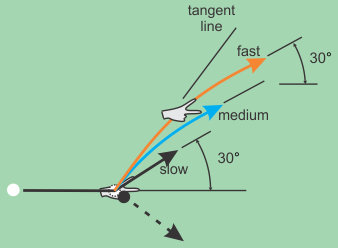How does Dr. Dave’s peace-sign technique work?
Here are good videos with explanations and demonstrations, the first from Vol. I of the Video Encyclopedia of Pool Shot, of how the peace-sign is used:
Here are some others:
- NV B.43 – Cue ball position control stun, roll, and draw reference lines
- NV B.44 – Dr. Dave 30° rule peace-sign hand calibration
You can use the 30° rule angle templates to calibrate and practice your peace sign.
You can also use your cue to help visualize the peace-sign finger direction or use an “air peace-sign” as demonstrated here:
“90° and 30° Rule Follow-up – Part V: the final chapter” (BD, June, 2005) wraps up a series of 12 (a year’s worth!) of articles dealing with the 90 and 30° rules. Diagram 2 of this article (see below) shows how you should move your hand to adjust for speed. It is fairly self-explanatory, but you can see the article and video demonstration below for more information:

The 30° rule applies for a wide range of shots. For more info, see when the 30° rule applies.
For details on how to apply the peace sign technique accurately for a wide range of shots and situations, see how to position the peace sign, “Peace Sign Subtleties” (BD, April, 2017), and “Air Peace Sign” (BD, October, 2022).
The peace-sign technique can also be applied to draw shots using the trisect system.
An alternative way to visualize the natural-angle direction is to imagine the mirror image of the ghost-ball on the back of the object ball. For more info and illustrations, see: “Back-of-the-Ball Aiming,” BD, September, 2016.
An alternative to using a peace sign is to pivot your cue as demonstrated here:
For more information, see: TP B.23 – Cue Pivot Point Required for Known CB Deflection.
How can you tell if your peace-sign is the correct angle?
See NV B.44. Also, here’s an angle template useful for learning how to apply the 30° rule accurately. The template can be used to help you train and calibrate your hand peace-sign (see “The 30° rule: Part I – the basics” – BD, April, 2004 and “90° and 30° Rule Follow-up – Part V: the final chapter” – BD, June, 2005).
One way to calibrate or check your peace sign at the table is to use your opposite hand index finger as a ruler to measure how much the tips of the “V” fingers should be spread. Using the 30° template or a 30-60-90 drafting triangle (available at office and arts and crafts stores), one can form the peace sign of the correct angles and then place the opposite-hand finger over the finger-tip gap, with the fingertip touching the tip of one of the fingers. Note where the second finger is relative to the other opposite-hand finger (e.g., just below the main knuckle, or at a certain wrinkle). Then (e.g., when you are playing), you can check your peace sign spread by recreating the same finger tip positions on your opposite hand.
Do people really use the 30° rule peace-sign at the table?
If one has a critical shot close to a scratch, requiring precise caroms, needing ball break-up or avoidance, or with tight “traffic” of balls to negotiate, a well-calibrated peace sign can be extremely useful, allowing one to predict with confidence nearly exactly where the cue ball will go. One can adjust the peace sign slightly for the cut angle using the 30° rule angle template for help. One can also adjust for speed, as shown in “90° and 30° Rule Follow-up – Part V: the final chapter” (BD, June, 2005). Well-calibrated fingers can be much more accurate than intuition-based visualization.
Isn’t an outward-facing “peace sign” considered vulgar in many countries?
In medieval times, archers were considered the “weapons of mass destruction.” When they were captured by enemies, their index and middle fingers were sometime cut off to prevent the prisoners from using their weapon against the captors in the future. So when archers were approaching enemy forces in battle, they would often dramatically hold up their fingers (with an outward facing “V”) to tell their enemies: “Look, I still have my fingers, you bastards. Now die!” The gesture remained and evolved into a general insult, especially in countries with British influence. Americans liked being different from the Brits, so we further evolved it into the “one-finger salute” (“shooting the bird”).
However, Winston Churchill also used a peace sign (forward facing) to indicate “Victory” at the end of World War II. And hippies from the 1960s and 1970s in America used the peace sign as an anti-war symbol. And the peace sign is also very useful at a pool table in applying the 30° rule. “V” stands for versatile! The 30° rule “peace sign” could also be called the “Victory Sign” because it implies an impending victory (since it is so useful and effective), but most Americans have a stronger association with the “Peace Sign” interpretation. Peace and Love!
Just be careful if using the peace sign in some countries. Just don’t lift it up and point it at a somebody with the back side facing out. The 30° rule peace sign is not offensive if you keep it horizontal and only point it at the balls on the table, as intended.
Dr. Dave keeps this site commercial free, with no ads. If you appreciate the free resources, please consider making a one-time or monthly donation to show your support:
